Align GP750 Gyro Review
by John Salt
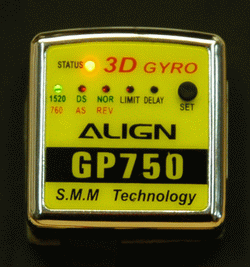 Align GP750 Gyro
Align GP750 GyroI have to admit, I wasn’t even considering an Align GP750 gyro when I was gyro shopping for my shinny new Trex 600ESP. I was going to stick with my tried and true Futaba GY401 .
In fact when I ordered my Rex 600 I just naturally ordered up a GY401 to go with it. It wasn’t until after I placed my order and started reading up on the GP750 that I realized how impressive this new gyro was, on paper anyways.
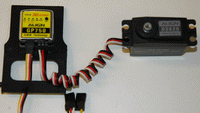 GP750 Gyro & DS620 Servo Combo Package
GP750 Gyro & DS620 Servo Combo PackageAt the last minute I phoned Wayne’s RC Hobbies and changed my order to the Align GP750 gyro paired with an Align high speed tail rotor specific DS620 digital servo.
Marilyn already had everything packed up, but as usual, was most accommodating with the last minute change.
Now that I have had a dozen or so flights with this new gyro, the only thing I can say is I have a new top pic when it comes to higher end gyro/servo combos.
Sorry Futaba, the GY401 has been dethroned and a new king in the RC heli gyro world has been crowned – at least in my RC heli hanger.
This is not to say the GY401 is bad, the Align GP750 gyro is just better with sophisticated programming and weighing in at half the weight.
Don’t think the Align GP750 gyro is cheaper however costing about 20 bucks more than Futaba’s 401; but the added features and reduced weight are well worth that 20.
Besides, the high speed DS620 digital tail servo is a real bargain at almost half the cost of Futaba’s S9254 – so that is where you can save some coin.
The first thing that tempted me towards the Align GY750 gyro is the fact it uses the same silicone micro machine (SMM) technology that Futaba has been using in their line of piezo crystal gyros for several years. Chances are the gyro crystal circuits are made by the same semi conductor manufacturing facility; but I can’t be certain of that of course. What I am sure about is how well Align’s SMM technology works at completely eliminating unwanted tail drift issues, just like Futaba’s.
Align has further improved the function of the SMM gyro sensor by placing a metallic dampening plate into the bottom of the gyro case to absorb both unwanted vibrations and electromagnetic interference.
The programming features of the Align GP750 gyro were the next big selling feature. Let’s face it, as good as the GY401 has, and continues to be, the technology is getting pretty old. Antiquated micro switch and potentiometers to set direction, delay, digital/analog mode, and servo travel. The Align GP750 is state of the art as far as programming goes. It offers all those features and is more easily programmed with one button, a left/right = yes/no input from your rudder stick and a confirmation LED color.
This example shows how the Align GP750 is programmed and how intuitive it is. Each function has a red and green option as you can see under the various LEDs.

Here I am setting the digital frame rate for the specific servo I am using, in this case a 1520 rate.
There are two LED’s to look at here.
The first one is what function you are programming. This is the green LED that is lit up above the 1520/760 numbers.
The next LED is the Status LED up in the left hand corner.
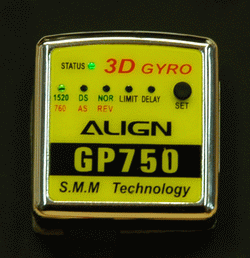
You simply move your rudder stick from left to right to change the Status LED color from red to green (red = 760, green = 1520) and then press the set button on the gyro.
That’s it; the frame rate is now set to 1520 micro seconds. The remaining settings are all done the same way.
No special programmers required or PC interfaces, just a logical straight forward approach.
The GP750 also has a true left and right servo travel limit adjustment over the simple overall travel adjustment that is offered on the GY401 ensuring full tail rotor pitch deflection in both directions with no servo binding – a very nice feature that anyone will appreciate from band newbie to advanced pro.
Digital frame rates setting? You Bet! You can choose between two different digital servo frame rates for the newest and fastest tail servos that are now using short 760 micro second rates for the new ultra fast 506 Hz frequencies, or you can set in the more conventional 1520 micro second rates for the conventional 280 Hz frequency (in digital mode only of course).
As I mentioned, the Align GP750 gyro still allows an analog tail servo to be used by selecting analog servo mode, but I found even with a fairly fast 0.13 sec/60 degree digital servo in analog mode, I had to set the gain rate as low as possible and use a long servo arm to eliminate tail hunting. The Align GP750 really should be used with a fast below 0.1 sec/60 digital servo that is capable of high frequency operation for best results and to get the performance out of the gyro that you are paying for.
The final feature that pushed me all the way to the Align GP750 gyro was the delay setting just like the 401 offers. There are few gyros out there that can be used in such a large size range of helis, and that is obviously why the Futaba GY401 has been so successful and outsells every gryo on the market. Well, Align didn’t miss that point and adding the versatility of a delay/helicopter mode(large or small) setting means this high tech gryo can be used in small micro electrics like the Trex 250 up to large 90 sized nitros with no reduction in performance.
Basically if it is a 400 class or smaller heli you select small, anything larger than a 400 class, select large. The rudder stick is then used to select the amount of delay in either mode to compensate for slower servos. Generally you want to set the delay to be as low as possible when paired with fast digital servos for the best performance.
Align’s DS620 Digital Servo
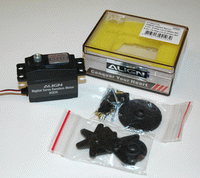 Align DS 620 Tail Servo
Align DS 620 Tail ServoAs I mentioned, I paired the GP750 with Align’s high speed tail specific DS620 digital servo. The selling point here was the cost (half of a Futaba S9254) and a tail servo that could operate at 6V meaning I didn’t have to worry about using 5V voltage regulator between the gyro and servo (many tail specific servos are designed to operate in the 4.8 volt region).
Not a big deal seeing that the Trex 600ESP Superior Combo kit includes a 5V regulator, but once again, if you can save some weight and a couple connectors, why not? At 6 volts the DS620 is as fast as the S9254 at 0.07 sec/60 degrees.
I have never owned an Align Servo before, but by knowing how good all of Align’s components are (mechanical and electrical) I figured they have to be just as good as a higher end Hitec servo. I certainly was not disappointed... The DS620 is a high end servo that retails where most other manufactures price their middle of the road digital's; once again proving that Align continues to offer serious bang for the buck. The first thing I noticed was the all aluminium center case half that acts as a large integrated heat sink to bleed off excesses heat to help keep the servo operating at maximum efficiency.
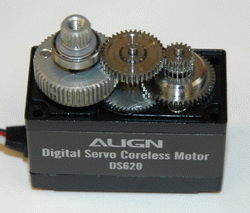 DS 620 Metal Gear Set
DS 620 Metal Gear SetI had to take a look at the much talked about gear set in this servo. This is almost a work of art in itself and would look more at place in a Swiss watch movement over a RC servo that is boasting smooth running, light weight, titanium alloy gears.
Moving the servo arm manually, you can really get an appreciation of the precise engineering by how smooth the gear mesh is with zero slop. Top all that off with a light weight and super efficient coreless motor and I can’t think of a better tail servo for the price. Like any high end digital servo, once powered up, the output shaft feels like it is glued into the case – low deadband and holding power are outstanding (10.0 kg/cm stall force at 6.0 volts).
Test Flights
Once I got that slow digital tail servo out and fit the DS620, some of the performance potential of the Trex 600ESP could be appreciated as well as how good the Align GP750 gyro really is.
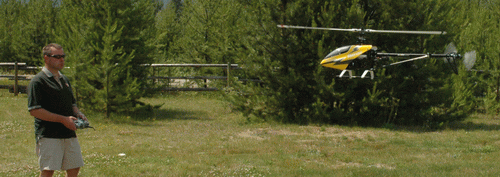 Testing The Align GP750 Gyro & DS 620 Tail Servo - No Drama
Testing The Align GP750 Gyro & DS 620 Tail Servo - No DramaI admit I am no 3D pilot, but that really doesn’t matter; as a sport, scale, or even brand newbie pilot just learning to fly, everyone will appreciate how nice this gyro is when paired with a fast digital tail servo from ease of programming and versatility down to the rock solid tail holding performance.
Align calls their heading hold gyro mode AHTCS (Active Helicopter Tail Control System). Call it whatever you like; bottom line is it can hold its own against any of the big gyro names out there. I know a very good 3D pilot who only uses Youngblood gyros and he said the Align GP750 would be his pick right now, so for those 3D guys and gals out there that might be reading this review, there ya go.
I originally had the gain rate set to 75% and was blown away by the locking performance on lighting fast pirouettes. No tail wag so I kept increasing up to 80% at which time a little wag started to show up. I backed it down to 75% in normal mode and 70% in flight modes 1 & 2.
The speed and locking ability of the GP750 / DS620 pairing is sick! Robotic tail lock took on a whole new meaning. I have never experience that kind of rush before from simple pirouettes. The Trex 600ESP is so fun to experience it on since with the quiet electric power plant, you can really hear the pitch change as that big tail rotor slaps back with total authority to lock the tail no matter how fast you are spinning. It is a noise you really have to experience first hand to appreciate and when the little hairs on the back of your neck stand on end – you know you have it dialed perfectly.
I feel one of the best tests to see how well a gyro can handle sudden torque changes is the old full power/ full pitch climb out. This puts the most amount of torque down in least amount of time. Lower cost gyro’s paired with slow servos fail miserably under these high torque conditions and can deviate off course sometimes as much as 135 degrees before making the correction and lock back on heading. Even a Futaba GY401 will show a little bit of deviation, but paired with a fast servo, it corrects for it in the blink of an eye.
The GP750/DS520 paring is without doubt the one of the best I have ever experienced in correcting for sudden high torque induced yaw. To be honest, I could only get perhaps a couple degrees of heading deviation with instant full power and +12 degrees of collective pitch. The correction was so quick, if you weren’t watching for it, you’d miss it.
It was unusually hot here over the past few days of testing and the Align GP750 Gyro was seeing temperature fluctuations from a comfortable 20C in the shop to scorching hot sun and gyro case temperatures over 35C. Not even one click of trim was required throughout several flights – tail drift was absolutely 100% non existent. Just like the GY401 the GP750’s SSM gyro sensor technology is totally drift free.
Final Thoughts
If you are in the market for the best bang for the buck when it comes to gyro performance, do yourself a big favor and check out Align’s GP750 gyro. Paired up with any of their or other manufacturer’s high speed tail specific digital servos and you will have the performance and high end features that were once reserved for only the best and most expensive gyros out there.
The Align GP750 gyro is now certainly one of the best, but lucky for us average Joe fliers on a budget, far from the most expensive.
If you are just new to the hobby and getting your first single rotor collective pitch machine, this is a gyro that you will appreciate for many years as it will grow with you. Yes it is certainly capable of the most demanding 3D performance, but as I said, the holding ability, zero drift, easy programming, and versatility is something every heli pilot no matter what your skill level will appreciate flight after flight. Of course if you are one of the gifted few who have 3D reflexes and nerves of steel, the Align GP750 gyro will keep up to what ever you want to throw at it.
Align GP750 Gyro Specs
- Type: Micro Heading Hold Gyro
- Sensor: SSM AHTCS with metallic dampening plate
- Weight = 14g
- Dimensions (WxLxH) 26 x 25 x 11mm
- Gain Setting : Remote Only
- Mode Setting: Rate or Heading Hold – Remote Only
- Operating Voltage: 4.5 to 7.0 VDC
- Current Consumption: <80mA @ 4.8V
- Angular Detection Speed: 500 degrees/sec









